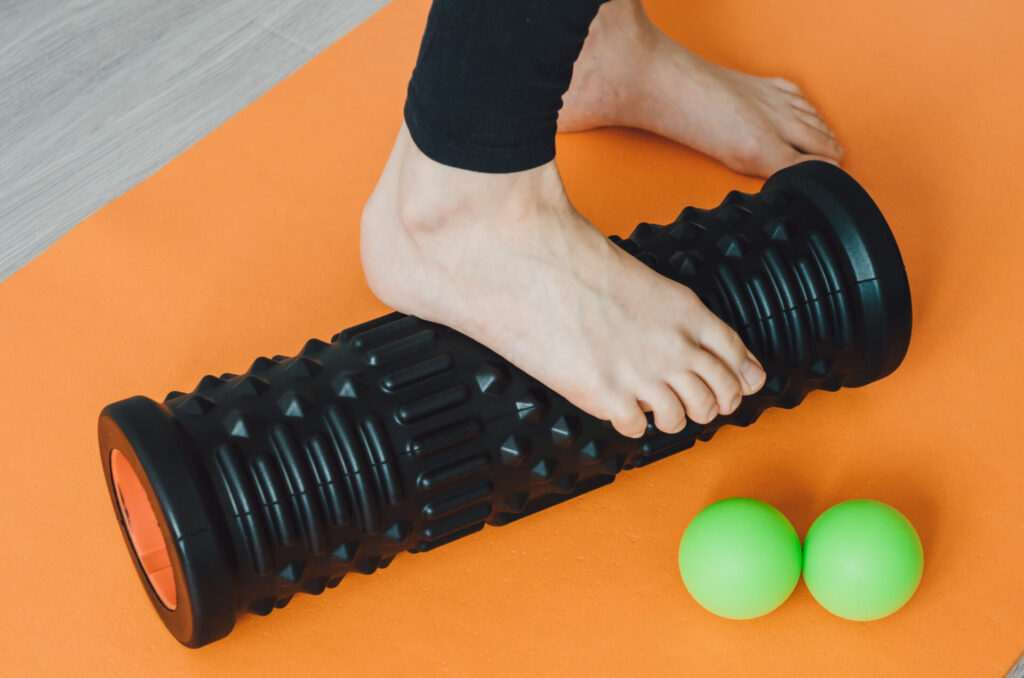Here Are Some Plantar Fascia Stretches You Can Do At Home
Plantar Fasciitis is inflammation with/without degeneration at the origin of Plantar Fascia – a thick tissue band at the bottom of the foot that runs from the toes to the heel. The main role of the tissue is to support your foot, act as a shock absorber, and support walking. It’s often caused by overuse, overstretching or it can be a result of another medical condition.
Heel Pain reduces after a few minutes of walking or doing an activity that stretches the Fascia. However, for some people, the pain reduces and returns after spending hours on their feet.
Plantar Fascia Stretches & Exercises
To help manage your pain, here are some simple plantar fasciitis stretches and exercises you can do in the comfort of your home.
-
Plantar Fascia Stretch
Sit down and cross your affected leg over your non-affected leg. With the hand of your affected side, grab your toes of the affected foot and pull them towards your shin. Hold this stretch for 10 seconds. This stretches the plantar fascia in the arch of the foot.
If you want to check if your foot is being stretched correctly, gently rub the thumb of the other hand over the arch of your affected foot while stretching. The plantar fascia should feel firm to the touch, similar to a guitar string.
-
Toe Stretches
Toe stretches can help to work the plantar fascia.
Sit in a chair, and extend your affected leg with your heel resting gently on the ground. Reach down towards your foot, pulling your big toe up and back. At the same time, pull toward your ankle and away from the ground. Hold this for between 15 and 30 seconds, however long you can handle the stretch. Repeat these toe stretches several times a day for maximum effect.
-
Rolling Stretches
Rolling stretches can be useful for tight muscles in your foot (or other parts of your body too). Find a suitable round object and place it under your affected foot. Roll it back and forth under the arch of your foot several times, for around 1-2 minutes in total.
You could use any small ball for this (e.g. a tennis or golf ball) a rolling pin, or you could buy a specialized foam roller.
-
Calf Stretches
Tight muscles in your calves and legs can have a knock-on effect on your plantar fasciitis, so some simple calf stretches can help too.
For an effective calf stretch, press your hands against a wall and bend your leg which is unaffected. Keep your affected leg straight. Both feet remain flat on the floor, so you should feel a stretch in the calf of the straight leg. Hold the calf stretch for up to 10 seconds at a time. You can repeat this stretch 2 or 3 times in a row with short breaks in between.
-
Towel Curls
Another calf stretch that can help plantar fasciitis is a towel curl. It’s a particularly good warm up stretch to do before getting out of bed each morning.
Lay a small towel or facecloth on the floor. Sit on a chair or the edge of your bed. Using your toes pick up the centre of the towel and curl it towards you. Relax your toes, then repeat the exercise up to 5 times.
-
Marble Pickups
To help stretch your foot muscles, try picking up marbles with your toes.
Get a bowl and around 10-20 marbles. Sit on a chair and keep both your feet flat on the ground. Put the bowl and the marbles on the floor (gently so they don’t all roll away!). One at a time, pick up a marble and place it in the bowl. This action forces you to curl your toes and use muscles that can sometimes be stiff and painful. Repeat until you’ve collected all the marbles.
-
Foot Flexes
Using a stretch band, you can perform these foot flex stretches to help relieve tension in your calves.
Sitting on the floor, straighten your legs out in front of you. Place the elastic/stretch band around your affected foot and hold the ends of the band tightly in your hands. Gently flex your foot so that your toes are pointing away from your body. Hold for a few seconds and then return your toes to their starting position. You can repeat this exercise up to 10 times for your affected foot.
All of these plantar fasciitis stretches and exercises can help you manage the pain associated with this condition. If you’re exercising, make sure you warm up slowly before undertaking any exercise and don’t overdo it. Wearing supportive shoes can make a world of difference as well. Speak to your podiatrist about what kind of shoes would be best for you and your feet.
Are you suffering from Plantar Fasciitis? One of our podiatrist can assist and then recommend what treatment options are best to get you back on track. ✅
Schedule an appointment here or you may call us at 44 (0) 207 101 4000. 📞
We hope you have a feetastic day! 👣☀️
-The Chelsea Clinic and Team




